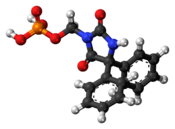
Back Ffosffenytoin Welsh Fosfenitoína Spanish ଫସଫେନିଟଏନ OR Fosfenitoină Romanian Fosfenitoin Serbo-Croatian Fosfenitoin Serbian
 | |
 | |
| Clinical data | |
|---|---|
| Trade names | Cerebyx, Pro-Epanutin |
| AHFS/Drugs.com | Monograph |
| MedlinePlus | a604036 |
| License data |
|
| Routes of administration | Intravenous, intramuscular |
| ATC code | |
| Legal status | |
| Legal status | |
| Pharmacokinetic data | |
| Bioavailability | 100% (IM) |
| Protein binding | 95–99% |
| Metabolism | Liver |
| Elimination half-life | 15 minutes to convert to phenytoin |
| Excretion | Kidney (as phenytoin) |
| Identifiers | |
| |
| CAS Number | |
| PubChem CID | |
| IUPHAR/BPS | |
| DrugBank | |
| ChemSpider | |
| UNII | |
| KEGG | |
| ChEMBL | |
| CompTox Dashboard (EPA) | |
| Chemical and physical data | |
| Formula | C16H15N2O6P |
| Molar mass | 362.278 g·mol−1 |
| 3D model (JSmol) | |
| |
| |
| | |
Fosphenytoin, also known as fosphenytoin sodium, and sold under the brand name Cerebyx among others, is a water-soluble phenytoin prodrug that is administered intravenously to deliver phenytoin, potentially more safely than intravenous phenytoin. It is used in the acute treatment of convulsive status epilepticus.
Fosphenytoin was developed in 1996.[2] On 18 November 2004, Sicor (a subsidiary of Teva) received a tentative approval letter from the United States Food and Drug Administration for a generic version of fosphenytoin.[3]
- ^ "FDA-sourced list of all drugs with black box warnings (Use Download Full Results and View Query links.)". nctr-crs.fda.gov. FDA. Retrieved 22 Oct 2023.
- ^ Pitkänen A, Schwartzkroin PA, Moshé SL (2005). Models of Seizures and Epilepsy. Burlington: Elsevier. p. 539. ISBN 9780080457024.
- ^ "Fosphenytoin Sodium Approval History". Retrieved 20 October 2005.